Speech prosody and pragmatic scalar inferences: Divergent cognitive strategies in adults with high and low levels of autistic traits
IF 1.7
1区 文学
0 LANGUAGE & LINGUISTICS
引用次数: 0
Abstract
Background
Given the communicative challenges associated with autistic traits (ATs), individuals with higher levels of ATs can sometimes make certain pragmatic inferences, such as quantifier scalar implicatures. However, it remains unclear whether they can effectively integrate prosodic cues when drawing these inferences.
Methods
This study examines scalar quantifier interpretations and reaction time (RT) among Mandarin-speaking adults using computer-based Picture-Sentence Judgment & Selection Tasks, considering prosodic cues and cognitive abilities. Samples included 18 adults with lower (11F, 7M) and 27 with higher (19F, 8M) levels of ATs.
Results
Our study found that when prosodic cues were present, low AT individuals showed greater delays in response times but were less likely to change their interpretations. This suggests heightened sensitivity to prosodic cues and stronger conviction in their initial judgments. Additionally, while prosodic focus affected cognitive factors in both groups, low AT individuals relied more on Theory of Mind (ToM), whereas high AT individuals relied more on Executive Functions (EFs).
Conclusions
Higher levels of ATs are linked to greater difficulty with pragmatic scalar inferences, but compensatory cognitive strategies offset this. This study highlights the role of prosodic focus and the distinct cognitive strategies used by individuals with varying levels of ATs.
言语韵律与语用标量推理:高、低水平自闭症成人的不同认知策略
考虑到与自闭症特征相关的交际挑战,具有较高水平自闭症特征的个体有时可以做出某些语用推断,如量词标量含义。然而,在进行这些推理时,他们是否能有效地整合韵律线索尚不清楚。方法采用基于计算机的图句判断和选择任务,考虑韵律线索和认知能力,研究普通话成人的标量量词解释和反应时间。样本包括18名ATs水平较低(11F, 7M)的成年人和27名ATs水平较高(19F, 8M)的成年人。结果我们的研究发现,当韵律线索存在时,低AT个体在反应时间上表现出更大的延迟,但不太可能改变他们的解释。这表明他们对韵律线索更敏感,对最初的判断更有信心。此外,尽管韵律焦点对两组的认知因素都有影响,但低AT个体更依赖于心智理论(ToM),而高AT个体更依赖于执行功能(EFs)。结论较高的ATs水平与较高的语用标量推理难度有关,但代偿性认知策略抵消了这一影响。这项研究强调了韵律焦点的作用,以及不同水平ATs个体使用的不同认知策略。
本文章由计算机程序翻译,如有差异,请以英文原文为准。
求助全文
约1分钟内获得全文
求助全文
来源期刊

Journal of Pragmatics
Multiple-
CiteScore
3.90
自引率
18.80%
发文量
219
期刊介绍:
Since 1977, the Journal of Pragmatics has provided a forum for bringing together a wide range of research in pragmatics, including cognitive pragmatics, corpus pragmatics, experimental pragmatics, historical pragmatics, interpersonal pragmatics, multimodal pragmatics, sociopragmatics, theoretical pragmatics and related fields. Our aim is to publish innovative pragmatic scholarship from all perspectives, which contributes to theories of how speakers produce and interpret language in different contexts drawing on attested data from a wide range of languages/cultures in different parts of the world. The Journal of Pragmatics also encourages work that uses attested language data to explore the relationship between pragmatics and neighbouring research areas such as semantics, discourse analysis, conversation analysis and ethnomethodology, interactional linguistics, sociolinguistics, linguistic anthropology, media studies, psychology, sociology, and the philosophy of language. Alongside full-length articles, discussion notes and book reviews, the journal welcomes proposals for high quality special issues in all areas of pragmatics which make a significant contribution to a topical or developing area at the cutting-edge of research.
 求助内容:
求助内容: 应助结果提醒方式:
应助结果提醒方式:


